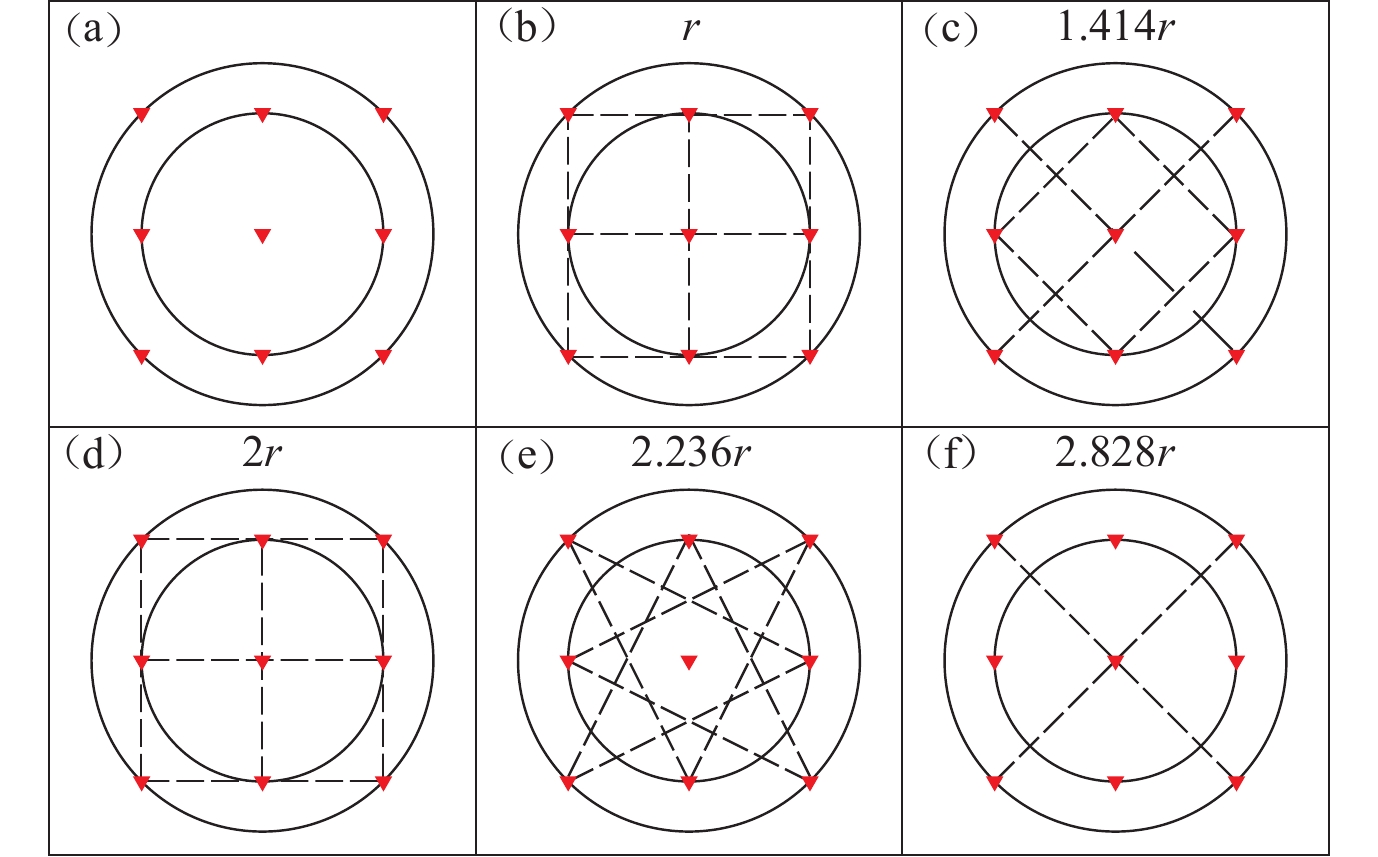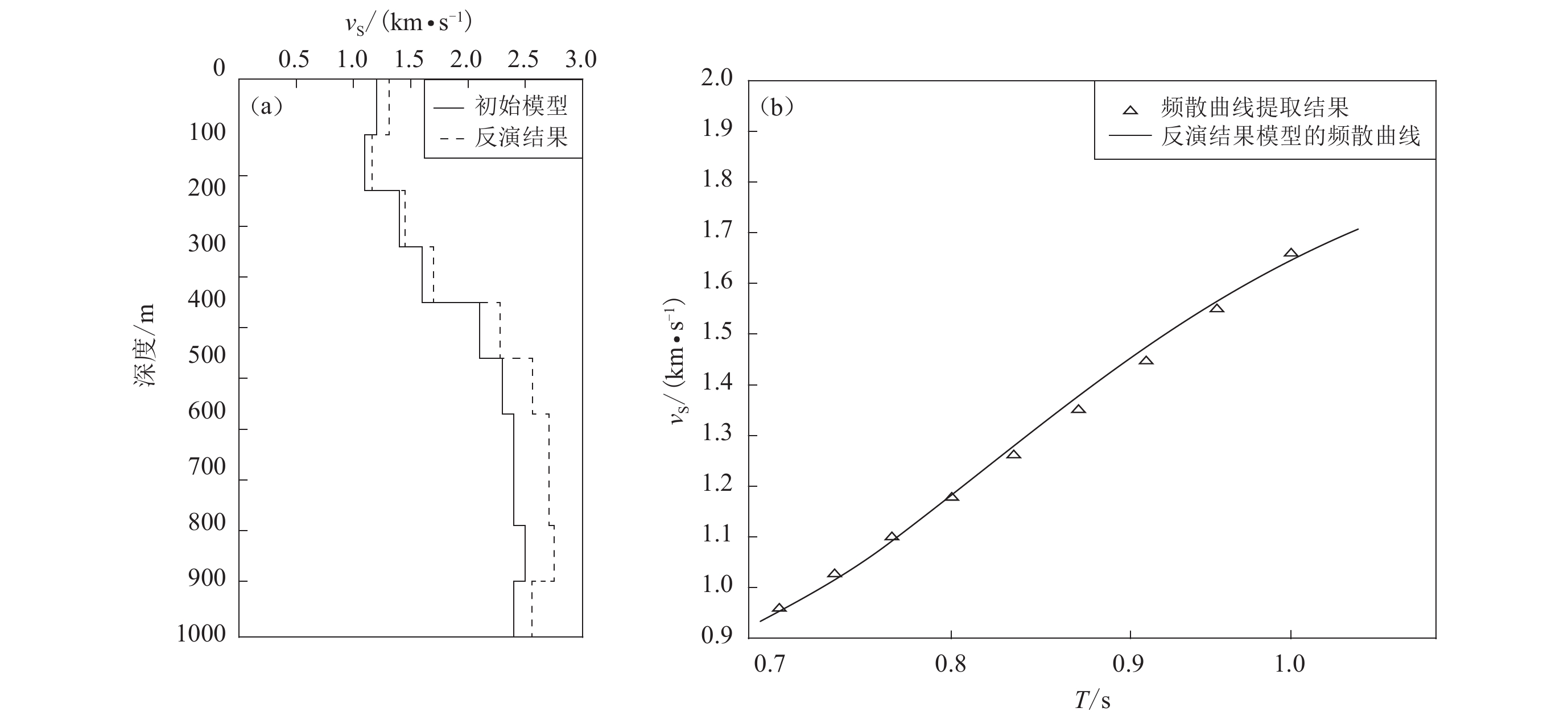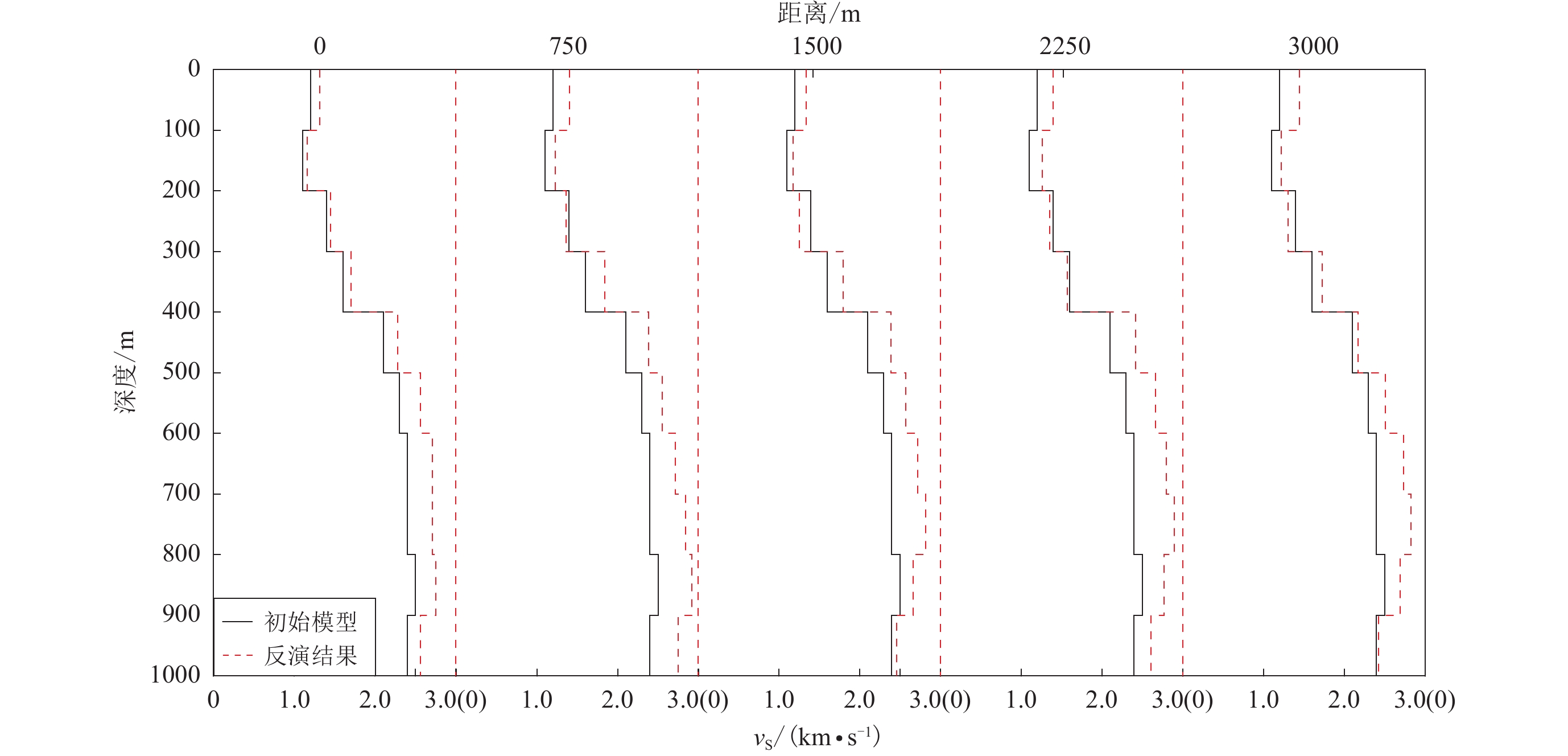Spatial autocorrelation method based on dense short-period seismic array and its application in the Guangdong-Hong Kong-Macao Greater Bay
-
摘要: 基于空间自相关法从粤港澳大湾区短周期密集台阵的21个观测点记录的微动信号中提取了瑞雷波频散曲线,并反演得到了广州市番禺区内布设的台阵下方1 km深度范围内的浅层S波速度结构。结果显示:台阵下方0.25 km深度以内的速度明显偏低,介于1.17 km/s到1.59 km/s之间;0.25—1 km深度之间的速度平稳增加至2.88 km/s,表明通过空间自相关法可以有效地获取观测台阵下方稳定可靠的浅层速度结构。因此短周期密集台阵技术与空间自相关法结合是在人口稠密的城市群地区进行地下浅层的精细结构探测的一种有效、经济、环保的手段,将在未来城市地区的浅层结构探测中发挥重要作用。
-
关键词:
- 短周期密集台阵 /
- 空间自相关(SPAC)法 /
- 频散曲线 /
- S波速度结构
Abstract: Based on spatial autocorrelation (SPAC) method, the dispersion curves of Rayleigh wave have been extracted from the microtremor recorded by 21 stations belong to the dense short-period array deployed in Guangdong-Hong Kong-Macao Greater Bay area, and then the inversion for shallow S-wave velocity structures within a depth of 1 km beneath the Panyu district, Guangzhou city, have been performed. The results show that the velocity beneath the array is obviously low within 0.25 km depth, ranging from 1.17 km/s to 1.59 km/s, while the velocity increases steadily to 2.88 km/s between 0.25 km to 1 km depth. This indicates that the stability and the reliability of the method, which also implies that the SPAC is an effective, economical and environmental method for detecting the shallow fine structures in densely populated urban areas, and it will play an increasingly important role in the exploration of shallow structure in urban areas in the future. -
引言
在大震孕育期间,断裂上可能发生小震,断裂两侧地块中也可能发生小震,但后者可能因原来介质中易滑面的方向不规则,在应力作用下所产生的微裂隙方向也不尽相同,因而该处发生的小震的震源机制可能也不相同,且与断裂带上小震的机制不相同;但至大震发生的短临阶段,小震主要分布在断裂带上,在高应力的背景下,其受力方式均相似,因而震源机制也相似。此外,由于它们与主震都是发生在同一断裂上的错动,所以其机制与主震震源机制也相似(郭增建等,1973)。震源机制一致性或是区分前震序列与一般震群的有效途径之一。目前,研究震源机制一致性的方法主要有:P波与S波最大振幅比法(金严等,1976;陈颙,1978)、谱振幅相关系数法(Lund,Bӧðvarsson,2002;崔子健等,2015)、断层面参数法(陈颙,1978)、主应力轴夹角差法(刁桂苓等,1992,1994,2004;程万正等,2006;李丽等,2015;孙丽娜等,2017;刘方斌等,2018a,b)、最小旋转角法(万永革,2008)、P轴分布集中度法(荣代潞,2014;韩晓明,荣代潞,2015)和应力张量非均匀性法(Michael,1991;Wiemer et al,2002;李金等,2015;张致伟等,2015)。这些方法主要着眼于描述震源机制一致性的变化,所得结果几乎都表明强震前中小地震的震源机制具有一致性增强的现象。震源机制一致性的提出始于前震的识别,对于前震的认定,时空范围要求非常严格,前震一般发生在主震前5天以内,距离主震震中20 km以内(陈颙等,2015)。随着研究的深入,震源机制一致性在地震趋势研判中应用越来越广泛,但一直没有明确以下两个问题:一是如何描述两个震源机制之间的一致性程度;二是对于若干次地震组成的一组地震,如何描述其震源机制一致性程度。为此,本文拟着眼于以上两个问题,利用统计显著性检验方法,提出用四维空间的欧氏距离来表示不同地震震源机制之间的一致性,并以1999年11月29日辽宁岫岩MS5.4地震前震序列为例,对震源机制一致性进行深入研究,以期为地震预测研究提供可操作的具体方法。
1. 方法
由一次地震的震源机制可给出两组节面的走向、倾角、滑动角,以及主应力P轴、T轴和B轴的方位角和俯角。若断层面的走向、倾角、滑动角已知即可确定震源机制,所以可用断层面的走向、倾角、滑动角这3个量来描述两次地震的震源机制一致性。但是,对于中小地震,由于难以确定震源机制的两个节面中哪个是断层面,震源机制节面的走向、倾角、滑动角不便用于描述震源机制一致性。地震是在震源应力场的作用下发生,只要两次地震的震源应力场一致,其震源机制就应当一致,因此可利用震源机制的主应力轴来描述震源机制一致性。由于我国上地壳内受到的应力场以水平向应力为主,该方向应力对中国大陆地震的孕育和发生起着重要作用(郭增建等,1977),所以本文选取震源机制的P轴和T轴来描述震源机制一致性。设φ为方位角,θ为俯角,P轴和T轴的方位角和俯角(φP,φT,θP,θT)对应于四维空间的一个点。这样,每次地震的震源机制可以对应于四维空间的一个点,它们之间的一致性就可以用欧氏距离来描述。对于地震i和j,其震源机制之间的欧氏距离为
${D_{\rm{FM}}} {\text{=}} \left[ {{{(\phi _P^i {\text{-}} \phi _P^j)}^2} {\text{+}} {{(\phi _T^i {\text{-}} \phi _T^j)}^2} {\text{+}} {{(\theta _P^i {\text{-}} \theta _P^j)}^2} {\text{+}} {{(\theta _T^i {\text{-}} \theta _T^j)}^2}}\right]^{1/2}{\text{,}}$


(1) DFM越小,两个震源机制的一致性越好,当DFM=0时,两个震源机制完全一致。但是,DFM小到什么程度就可以认为两个震源机制具有一致性呢?为了解决这个问题,本文利用1975年2月4日辽宁海城ML7.3地震序列和1999年11月29日辽宁岫岩MS5.4地震序列的震源机制进行分析。前者的震源机制采用顾浩鼎等(1976)的结果,具体列于表1;后者的震源机制采用张萍和蒋秀琴(2001)的结果,具体列于表2。利用表1和表2中的资料,按照式(1)计算前震、余震与主震之间的欧氏距离DFM,得到的结果分别列于表1和表2中的最后一列。
表 1 海城ML7.3地震ML≥4.0前震和余震的震源机制(引自顾浩鼎等,1976)及其与主震之间的欧氏距离DFM值Table 1. Focal mechanisms for ML≥4.0 foreshocks and aftershocks of the ML7.3 Haicheng earthquake (after Gu et al,1976) and their Euclidean distance DFM value序号 发震时刻 地理坐标 ML 深度
/km节面Ⅰ 节面Ⅱ P 轴 T 轴 B 轴 DFM 年-月-日 时:分:秒 东经/° 北纬/° 走向/° 倾角/° 滑动角/° 走向/° 倾角/° 滑动角/° 方位角/° 俯角/° 方位角/° 俯角/° 方位角/° 俯角/° 1 1975-02-04 07:50:47.0 122.75 40.67 4.7 17 110 85 25.1 17 65 174.5 61 15 157 22 300 64 18.85 2 1975-02-04 10:35:35.0 122.78 40.67 4.3 15 109 86 22.1 17 68 175.7 61 13 155 18 297 68 15.66 3 1975-02-04 19:36:06.0 122.80 40.65 7.3 12 290 81 −15.2 23 75 −170.7 66 17.5 157 4 100 72.5 0 4 1975-02-05 01:01:45.0 122.93 40.70 4.4 10 298 88 4.0 208 86 178.0 252 2 343 4 143 86 17.67 5 1975-02-05 02:56:29.0 122.82 40.67 4.5 10 112 88 6.0 22 84 178.0 66 3 157 6 310 83 14.64 6 1975-02-05 12:33:00.0 122.77 40.68 4.1 10 126 61 11.5 221 80 150.5 268 28 171 13 59 59 29.52 7 1975-02-05 23:52:54.0 122.63 40.70 4.6 10 125 64 5.6 217 85 153.9 264 22 168 14 47 64 23.77 8 1975-02-06 05:43:42.0 122.90 40.62 5.2 23 292 87 −2.0 22 88 −177.0 67 3 338 0 231 86 15.11 9 1975-02-06 12:24:57.0 122.50 40.80 5.4 17 162 80 34.6 259 56 167.9 295 31 35 16 149 54 132.71 10 1975-02-06 13:56:16.0 122.83 40.75 4.0 10 116 80 −128.9 14 40 −15.7 169 41 56 25 304 38 147.66 11 1975-02-08 02:30:23.0 122.47 40.82 4.0 12 161 78 −31.8 262 59 −166.0 293 38 37 18 148 48 131.25 12 1975-02-12 20:42:46.0 122.78 40.70 4.0 7 143 52 −118.2 3 46 −58.9 171 68 73 3 341 22 143.64 13 1975-02-15 21:08:02.0 122.78 40.70 5.4 12 111 84 26.2 18 64 173.3 62 14 158 22 303 63 18.79 14 1975-02-16 22:01:26.0 122.80 40.68 5.3 11 123 62 6.8 30 84 151.8 260 15 163 24 20 62 25.26 15 1975-02-18 18:51:49.0 122.65 40.77 4.2 17 114 44 14.5 14 80 133.1 252 23 142 39 5 42 38.94 16 1975-02-22 15:45:14.0 122.73 40.70 4.0 12 113 85 36.2 19 54 173.8 60 21 162 29 300 54 26.42 17 1975-02-24 05:07:20.0 122.88 40.78 4.4 7 132 57 −52.9 258 48 −132.9 278 60 17 5 110 30 149.77 18 1975-02-25 04:52:10.0 122.62 40.73 4.4 14 134 74 −4.2 226 86 −164.0 276 14 180 8 62 74 159.93 19 1975-02-26 05:09:53.0 122.82 40.67 4.3 8 121 90 20.0 210 70 180.0 254 14 347 14 121 70 16.62 20 1975-03-21 11:32:59.0 122.95 40.77 4.0 11 260 72 −29.6 0 62 −159.5 38 34 132 7 231 56 41.11 21 1975-03-29 23:16:36.0 122.60 40.77 4.1 6 111 85 24.1 19 66 174.5 63 13 158 20 303 65 16.92 22 1975-04-10 03:55:37.0 122.48 40.72 4.6 10 118 85 9.0 27 81 184.9 253 3 163 10 357 80 18.20 23 1975-04-21 00:17:06.0 122.45 40.77 4.0 8 109 84 30.2 16 60 173.1 59 17 157 25 299 59 22.14 24 1975-07-04 07:06:29.0 122.67 40.72 4.1 10 137 56 −19.4 239 74 −144.4 283 36 185 12 80 52 157.73 表 2 岫岩MS5.4地震MS≥4.0前震和余震的震源机制解(引自张萍,蒋秀琴,2001)及其与主震之间的欧氏距离DFM值Table 2. Focal mechanisms for MS≥4.0 foreshocks and aftershocks of the MS5.4 Xiuyan earthquake (after Zhang,Jiang,2001) and their Euclidean distance DFM value序号 发震日期 地理坐标 MS 深度
/km节面Ⅰ 节面Ⅱ P 轴 T 轴 B 轴 DFM 年-月-日 时:分:秒 东经/° 北纬/° 走向/° 倾角/° 滑动角/° 走向/° 倾角/° 滑动角/° 方位角/° 俯角/° 方位角/° 俯角/° 方位角/° 俯角/° 1 1999-11-09 07:01:40.6 123.03 40.53 4.1 9 320 70 7.5 228 83 159.8 261 26 358 11 208 70 159.33 2 1999-11-09 07:07:21.2 123.02 40.53 4.2 8 137 80 −7.1 228 83 −169.9 62 18 331 3 84 77 158.79 3 1999-11-25 20:47:48.5 123.00 40.55 4.0 8 137 44 29.5 27 70 130.0 56 25 150 8 11 38 39.46 4 1999-11-25 20:55:4.2 123.00 40.55 4.4 9 139 42 30.7 27 70 127.7 271 12 167 46 12 36 42.50 5 1999-11-26 23:34:01.0 123.02 40.53 4.4 9 110 70 10.6 24 80 159.7 246 15 152 12 46 67 17.00 6 1999-11-29 12:10:39.2 123.03 40.53 5.4 9 296 84 −20.1 28 70 −173.6 62 41 191 36 280 70 0 7 1999-11-29 12:45:50.4 123.03 40.53 5.1 9 300 70 173.6 206 84 20.1 12 40 262 22 193 68 11.36 8 1999-11-29 16:16:47.6 123.03 40.53 5.0 8 111 80 20.3 17 70 169.4 248 20 341 8 324 67 16.52 9 1999-11-30 07:52:55.8 123.03 40.53 4.0 9 111 68 13.0 15 78 157.5 262 32 162 15 348 65 24.78 10 1999-11-30 13:58:17.7 123.03 40.53 5.2 9 291 80 −16.3 26 74 −169.6 270 15 180 2 260 70 9.33 11 1999-11-30 14:06:55.1 122.98 40.55 4.9 8 292 72 10.5 197 80 161.7 41 22 133 10 166 70 18.25 12 1999-11-30 14:09:36.6 123.02 40.55 4.3 9 112 58 11.8 16 80 147.4 77 28 350 3 357 57 20.22 13 1999-11-30 20:19:44.2 123.03 40.53 4.3 9 295 83 −20.2 28 70 −172.5 293 25 37 25 279 70 4.69 14 1999-12-01 01:47:1.9 123.03 40.53 4.2 9 290 80 10.2 198 80 169.8 67 22 338 6 154 78 17.03 15 1999-12-01 04:33:0.5 123.03 40.53 4.4 9 110 80 30.5 14 60 168.4 4 28 274 0 307 60 20.71 16 1999-12-01 12:45:30.8 123.03 40.55 4.3 9 299 70 10.6 205 80 159.7 290 14 18 2 117 68 16.64 17 1999-12-13 05:49:30.5 123.08 40.53 4.1 11 137 60 23.3 36 70 147.9 79 42 346 2 8 52 38.18 18 1999-12-27 19:27:15.4 123.02 40.53 4.0 8 112 70 10.6 19 80 159.7 91 30 0 9 356 66 14.73 19 2000-01-12 07:43:55.4 123.05 40.53 5.5 8 146 80 −40.7 256 50 −166.9 70 25 333 13 139 50 140.51 20 2000-01-12 13:00:31.9 123.03 40.55 4.3 9 112 88 26.0 20 64 177.8 269 13 359 1 297 62 10.20 由表1最后一列的DFM值可见:海城ML7.3地震序列MS≥4.0前震和余震的DFM值分布在14—42范围之内的有16次,占69.57%,分布在131—160之内的有7次,占30.43%。两次前震的DFM值分别为18.85和15.55。图1给出了不同DFM值的前震和余震的震源机制图像,同时也给出了海城ML7.3地震的震源机制。可以看出:DFM值分布在14—42之内的地震,其震源机制与主震极为接近;而DFM值分布在131—160之内的地震,其震源机制与主震差别较大。
由表2最后一列的DFM值可见:岫岩MS5.4地震序列ML≥4.0前震和余震的欧式距离DFM值分布在4—43之内的有16次,占84.21%;DFM值分布在140—160之内的有3次,占15.79%;临近主震的3个前震的DFM值分别为39.46,42.5和17.0,均在43以下。
通过上述对两个地震序列的前震和余震的DFM值的分析,我们认识到,与主震震源机制相近的地震的DFM值均在43以下。故对于两次地震而言,其震源机制相近的条件可以适当放宽至DFM<50.
对于若干次地震组成的一组地震,一般来讲各次地震的震源机制不一致,在这种情况下,可以用其欧式距离DFM平均值确定与某次地震震源机制的一致性,但只能显示一致性的强弱,不能确定是否一致或在多大程度上一致。陈颙(1978)给出了参数K来描述一组地震震源机制的一致性,假设N次地震中震源机制一致的地震次数为n1,不一致地震的次数为n2,K定义为
$K {\text{=}} \frac{{{n_1} {\text{-}} {n_2}}}{N}{\text{,}}$


(2) K在−1到1之间变化,K>0表示震源机制一致的地震比不一致的地震多,但是当K值为多大时一致性才显著尚未解决。本文将N次地震根据DFM值分为两部分,一部分地震的次数为n1,DFM>50;另一部分地震的次数为n2,DFM≥50;然后,根据式(2)计算K值。当N≤25时,可用符号检验法对一组地震的震源机制是否一致进行统计显著检验;当N≥25时,可采用
$ Z {\text{=}} \dfrac{{r {\text{-}} 0.5 {\text{-}} \dfrac{N}{2}}}{{\dfrac{{\sqrt N }}{2}}} $


(3) 统计检验量Z进行检验(张敏强,2010)。式(3)中:r为n1和n2两者中的较大者;Z为显著性水平α=5%,2%和1%下的临界值,分别为1.96,2.33和2.58。一般地,如果Z≥1.96,表示能通过α=5%的显著性检验,可以认为这组地震震源机制的一致性显著。
2. 岫岩MS5.4地震前小震震源机制一致性
本文将利用上述方法对岫岩MS5.4地震序列的震源机制与MS5.4主震震源机制之间的一致性进行分析。选取1999年1月至11月岫岩MS5.4主震发生前41次2.5≤ML≤3.9小震的震源机制解(张萍等,2003),其空间分布如图2所示,震源机制解参数列于表3。图3给出了这些小震与主震之间DFM值的变化,可见:DFM值集中分布在4—45和84—163这两个区间,前者有30次,后者有11次。在临近主震发生的1999年11月份,共发生21次小震,其中DFM≤45的17次,DFM≥84的4次。按上述方法,以DFM=50将地震进行划分,不会影响结果。
表 3 1999年岫岩MS5.4地震前小震震源机制Table 3. Focal mechanisms for small earthquakes before the MS5.4 Xiuyan earthquake in 1999序号 发震日期 地理坐标 MS 深度
/km节面Ⅰ 节面Ⅱ P 轴 T 轴 B 轴 年-月-日 时:分:秒 东经/° 北纬/° 走向/° 倾向 倾角/° 走向/° 倾向 倾角/° 方位角/° 俯角/° 方位角/° 俯角/° 方位角/° 俯角/° 1 1999-01-15 03:05:18.6 122.62 40.65 3.4 11 128 WS 80 42 NW 62 261 26 358 11 110 59 2 1999-01-06 05:43:10.9 122.82 40.65 2.9 10 105 NE 76 17 ES 80 62 18 331 3 233 72 3 1999-01-20 07:37:43.4 122.53 40.70 3.2 12 101 NE 80 13 ES 70 56 25 150 8 259 65 4 1999-04-09 16:31:48.0 121.00 42.00 3.0 15 138 WS 52 32 ES 70 271 12 167 46 12 43 5 1999-04-23 21:13:38.4 122.82 40.70 2.9 7 107 WS 70 20 NW 86 246 15 152 12 13 68 6 1999-04-27 15:14:14.4 124.57 41.12 2.8 13 125 NE 85 40 ES 30 62 41 191 36 304 30 7 1999-04-30 21:16:13.3 122.85 39.68 2.7 5 142 NE 78 60 NW 42 12 40 262 22 152 39 8 1999-05-11 12:29:25.9 122.78 40.65 3.4 14 114 WS 80 27 NW 70 248 20 341 8 90 68 9 1999-05-15 01:45:46.6 122.22 39.38 3.1 10 118 WS 55 35 NW 80 262 32 162 15 50 52 10 1999-05-22 20:40:45.1 122.47 40.73 3.4 9 133 WS 82 46 NW 80 270 15 180 2 93 78 11 1999-05-24 15:58:35.1 122.20 41.70 2.5 28 86 NW 80 0 NE 68 41 22 133 10 246 67 12 1999-05-29 03:13:30.9 121.00 42.00 3.3 21 119 NE 70 34 ES 72 77 28 350 3 253 64 13 1999-06-03 01:46:50.2 122.25 41.67 3.4 8 75 NW 64 164 NE 90 293 25 37 25 164 64 14 1999-06-06 16:51:47.4 122.82 40.65 2.8 14 110 NE 70 26 ES 80 67 22 338 6 231 66 15 1999-08-21 12:56:25.9 121.70 41.25 2.7 21 142 NE 70 45 NW 70 4 28 274 0 183 61 16 1999-08-31 15:11:21.0 122.23 39.35 2.9 14 153 WS 80 64 NW 80 290 14 18 2 108 75 17 1999-09-06 05:05:30.3 122.67 40.70 3.1 6 114 NE 58 41 ES 64 79 42 346 2 252 47 18 1999-09-20 13:22:57.0 122.67 40.68 2.9 5 136 NE 62 52 ES 76 91 30 0 9 256 58 19 1999-10-10 07:21:15.5 122.95 40.65 2.8 9 109 NE 59 24 ES 80 70 25 333 13 219 56 20 1999-10-12 16:04:20.3 122.18 40.48 3.4 14 132 WS 80 46 NW 80 269 13 359 1 87 74 21 1999-11-04 14:46:26.9 122.60 39.27 3.5 7 118 WS 57 14 ES 70 152 39 252 5 348 50 22 1999-11-09 03:34:1.3 121.57 38.52 3.9 9 114 NE 62 22 ES 90 270 37 139 37 22 25 23 1999-11-09 08:21:36.2 123.00 40.53 2.9 8 118 NE 70 32 ES 80 77 20 345 7 240 67 24 1999-11-09 17:44:44.6 123.00 40.53 3.6 8 121 NE 70 34 ES 80 80 20 347 8 238 67 25 1999-11-16 18:57:48.5 123.00 40.53 3.0 9 110 NE 90 20 ES 60 61 21 161 21 291 60 26 1999-11-17 03:09:31.4 123.00 40.53 2.7 9 112 WS 70 24 NW 82 249 20 156 9 43 70 27 1999-11-17 23:59:50.8 123.00 40.55 2.5 9 102 WS 80 14 NW 84 239 11 148 4 46 77 28 1999-11-18 08:15:41.2 123.00 40.53 2.8 9 111 NE 80 29 ES 50 62 37 167 20 280 48 29 1999-11-21 00:50:1.9 123.00 40.55 3.0 8 122 NE 72 40 ES 70 81 28 172 2 265 64 30 1999-11-25 00:59:19.2 123.00 40.55 3.0 8 112 NE 80 32 ES 42 60 39 172 25 283 40 31 1999-11-25 21:17:50.8 123.00 40.53 3.5 8 138 NE 70 55 ES 70 96 30 187 1 278 61 32 1999-11-25 22:08:12.4 123.00 40.53 3.2 8 147 WS 76 61 NW 80 285 18 194 2 92 73 33 1999-11-25 23:19:17.5 123.00 40.55 3.2 8 110 WS 80 24 NW 70 246 20 338 6 84 67 34 1999-11-26 03:18:23.3 123.00 40.55 2.7 9 123 NE 72 39 ES 70 80 27 171 1 263 61 35 1999-11-26 23:36:20.7 123.00 40.53 3.1 9 112 NE 60 38 ES 60 77 40 344 3 253 46 36 1999-11-27 01:33:26.6 123.00 40.53 2.6 8 148 WS 80 53 ES 68 192 21 99 8 350 65 37 1999-11-27 02:29:43.7 123.00 40.55 2.8 8 122 WS 74 38 NW 68 260 23 350 2 92 63 38 1999-11-27 15:48:2.6 123.00 40.55 3.2 8 118 WS 80 36 NW 50 250 37 354 20 107 47 39 1999-11-28 08:15:3.6 122.98 40.55 3.3 8 108 NE 86 20 ES 62 60 21 156 17 279 61 40 1999-11-29 05:56:59.9 123.00 40.55 3.2 9 121 NE 80 31 ES 47 61 37 167 20 281 46 41 1999-11-29 09:25:51.2 123.00 40.53 2.7 8 126 NE 38 44 ES 86 99 37 346 29 226 60 取20次地震为1组,计算其DFM平均值,以2次地震进行滑动,得到DFM平均值随时间的变化,如图4所示。可以看出:DFM平均值从1999年11月中旬开始逐渐下降,临近主震发生前降至最低。尽管这样,DFM平均值与震源机制一致性之间的相关性仍然存疑。
同样取20次地震为一组,以DFM=50为界,将地震分为两组,然后按式(2)计算K值。以1次地震进行滑动,得到K值随时间的变化,如图5a所示。查阅符号检验表可知,在N=20的情况下:当n1=15时,可以在显著性水平α=5%下通过显著性检验,表示这20次地震的震源机制一致性的置信度可达95%;当n1=17时,可以在显著性水平α=1%下通过显著性检验,表示这20次地震的震源机制一致性的置信度可达99%。从图5a中可以看出:至1999年11月27日,K值达到0.6,超过α=5%的显著性水平检验的临界值;最后,K值达到α=1%显著性水平检验的临界值,即最后20次地震的震源机制一致性的置信度高达99%。
取26次地震为一组,按式(3)计算Z值进行检验。以1次地震进行滑动,得到Z值随时间的变化,如图5b所示。可见:在临近主震发生时,Z值最高可达2.55,超过α=2%的显著性水平检验的临界值,即最后26次地震的震源机制一致的置信度超过98%。
3. 震源机制一致性检验方法在地震预测中的应用
上述分析是在主震震源机制已知的情况下,通过计算前震与主震的欧式距离DFM值而进行的,而在地震预测实际工作中,主震尚未发生,其震源机制未知。这种情况下,可以在已经发生的若干次地震中,选取一次地震的震源机制作为主震的震源机制,计算其它地震与该地震之间的DFM值,再利用上述方法进行分析。表3中最后一次地震与主震之间的DFM值为40,其震源机制与主震一致,若将其震源机制作为主震的震源机制,所得DFM值如图6a所示,可以看出与图4中给出的结果基本一致。而表3中第36次地震与主震之间的DFM值为84,其震源机制与主震不一致,若将其震源机制作为主震的震源机制,所得DFM值如图6b所示,可见与图4中给出的结果相差甚远,因此,若某次主震的前震中有与主震震源机制一致的地震,那么在主震发生前将该地震的震源机制当成主震的震源机制进行分析,所得结果与之后发生的主震得到的结果完全一致。因此,本文提出的方法能较好地应用于实际地震预测。
4. 讨论与结论
地震发生的根本原因是应力作用下的岩石破裂。陈颙(1978)发现邢台地震和海城地震前,中小地震的破裂方式趋于一致,也就是说,岩石在高应力背景的作用下,微裂隙的方向基本相同,即中小地震的破裂方式相同,并基于这样的物理认识,提出震源机制一致性可以作为描述地震活动的新参数,即用一组地震震源断层面走向均值的标准偏差,或用震源机制解参数来描述地震机制的一致或混乱程度,以探索孕震区内背景构造应力场的动力学过程。该方法中震源机制一致性参数是个相对的概念。泽仁志玛等(2009,2010)提出用震源机制一致性参数来研究应力场取向的变化,以此来获取构造运动的情况及强震的前兆信息。但该方法需要事先确定背景应力场,因此具有很大的不确定性,而且对于如何描述两个震源机制之间的一致性程度以及对于若干次地震组成的一组地震,如何描述其震源机制一致性程度均无明确的回答。鉴于此本文提出了利用震源机制的P轴和T轴的方位角和俯角来计算两次地震之间的震源机制欧式距离DFM,并分析了1975年辽宁海城ML7.3地震序列和1999年辽宁岫岩MS5.4地震序列的主震与前震和余震的震源机制一致性与DFM值之间的关系。结果表明,当DFM<50时,二者震源机制接近。在此基础上,利用符号检验法和统计检验量Z值检验法对岫岩MS5.4地震前小震的震源机制一致性进行了分析,所得结果表明,在岫岩MS5.4地震前发生的短临地震,其震源机制一致性显著,置信度达98%,故本文提出的方法可以在地震预测实际工作中得以有效应用。当然,本文仅提出了震源机制一致性参数的计算方法及两个震例的研究,具体的震情判断指标尚需进一步研究。下一步如果能在基于应力状态演化的物理背景下结合其它观测手段进行地震预测,将会更加行之有效。这还需要更多震例的研究,或更长时间的检验。
-
表 1 研究区所用地震仪的主要性能指标
Table 1 Main parameters of the seismometers used in the studied region
地震仪 记录道数 ADC分辨率/bits 采样频率/ms 动态范围/dB 时间精度/μs SmartSolo IGU-16HR 3C 3 24 0.25,0.5,1,2,4,8,10,20 125 ±10,GPS驯服 Zland 3C 3 24 0.5,1,2,4 127 ±10,GPS驯服 -
雷华,潘素珍,田晓峰,刘巧霞. 2019. 短周期密集台阵探测的应用进展[J]. 地质论评,65(增刊1):287–288. doi: 10.16509/j.georeview.2019.s1.135 Lei H,Pan S Z,Tian X F,Liu Q X. 2019. Recent application progress of short-period seismic dense array[J]. Geological Review,65(S1):287–288 (in Chinese).
刘庆华,鲁来玉,何正勤,胡刚,王凯明,龚艳. 2016. 地脉动空间自相关方法反演浅层S波速度结构[J]. 地震学报,38(1):86–95. doi: 10.11939/jass.2016.01.008 Liu Q H,Lu L Y,He Z Q,Hu G,Wang K M,Gong Y. 2016. Inversion of S-wave velocity structure near the surface by spatial autocorrelation technique of microtremors[J]. Acta Seismologica Sinica,38(1):86–95 (in Chinese).
裴文. 2011. 广州亚运城场区地层土性相关关系研究[D]. 广州: 华南理工大学: 35–37. Pei W. 2011. A Study of the Correlations Between Different Characteristic Index of Strata Soils in the Area of Asia Game Town, Guangzhou[D]. Guangzhou: South China University of Technology: 35–37 (in Chinese).
任彦宗,卢占武,张新彦,薛帅,刘子龙,程永志,蔡玉国. 2021. 便携式节点地震仪数据采集和处理技术进展[J]. 地球物理学进展,36(2):779–791. doi: 10.6038/pg2021EE0097 Ren Y Z,Lu Z W,Zhang X Y,Xue S,Liu Z L,Cheng Y Z,Cai Y G. 2021. Progress in data acquisition and processing technology of portable node seismographs[J]. Progress in Geophysics,36(2):779–791 (in Chinese).
孙勇军,徐佩芬,凌甦群,李传金. 2009. 微动勘查方法及其研究进展[J]. 地球物理学进展,24(1):326–334. Sun Y J,Xu P F,Ling S Q,Li C J. 2009. Microtremor survey method and its progress[J]. Progress in Geophysics,24(1):326–334 (in Chinese).
王振东. 1990. 微动应用技术讲座(第一讲)[J]. 国外地质勘探技术,(4):12–16. Wang Z D. 1990. The lecture on microtremor application technology (chapter one)[J]. Foreign Geoexploration Technology,(4):12–16 (in Chinese).
徐佩芬,李传金,凌甦群,张胤彬,侯超,孙勇军. 2009. 利用微动勘察方法探测煤矿陷落柱[J]. 地球物理学报,52(7):1923–1930. doi: 10.3969/j.issn.0001-5733.2009.07.028 Xu P F,Li C J,Ling S Q,Zhang Y B,Hou C,Sun Y J. 2009. Mapping collapsed columns in coal mines utilizing microtremor survey methods[J]. Chinese Journal of Geophysics,52(7):1923–1930 (in Chinese).
徐佩芬,侍文,凌甦群,郭慧丽,李志华. 2012. 二维微动剖面探测“孤石”:以深圳地铁7号线为例[J]. 地球物理学报,55(6):2120–2128. doi: 10.6038/j.issn.0001-5733.2012.06.034 Xu P F,Shi W,Ling S Q,Guo H L,Li Z H. 2012. Mapping spherically weathered ‘Boulders’ using 2D microtremor profiling method:A case study along subway line 7 in Shenzhen[J]. Chinese Journal of Geophysics,55(6):2120–2128 (in Chinese).
Aki K. 1957. Space and time spectra of stationary stochastic waves,with special reference to microtremors[J]. Bull Earthq Res Inst,35(3):415–456.
Asten M W. 2006. On bias and noise in passive seismic data from finite circular array data processed using SPAC methods[J]. Geophysics,71(6):V153–V162. doi: 10.1190/1.2345054
Asten M W,Stephenson W J,Hartzell S. 2019. Spatially averaged coherencies (krSPAC) and Rayleigh effective-mode modeling of microtremor data from asymmetric arrays[J]. Geophysics,84(3):EN47–EN56. doi: 10.1190/geo2018-0524.1
Capon J. 1969. High-resolution frequency-wavenumber spectrum analysis[J]. Proc IEEE,57(8):1408–1418. doi: 10.1109/PROC.1969.7278
Herrmann R B, Ammon C J. 2002. Computer programs in seismology: Surface waves, receiver functions and crustal structure[CP/OL]. [2015-02-18]. http://www.eas.slu.edu/eqc/eqccps.html.
Li Z W,Ni S D,Zhang B L,Bao F,Zhang S Q,Deng Y,Yuen D A. 2016. Shallow magma chamber under the Wudalianchi Volcanic Field unveiled by seismic imaging with dense array[J]. Geophys Res Lett,43(10):4954–4961. doi: 10.1002/2016GL068895
Li Z W,Ni S D,Roecker S,Bao F,Wei X,Yuen D A. 2018. Seismic imaging of source region in the 1976 MS7.8 Tangshan earthquake sequence and its implications for the seismogenesis of intraplate earthquakes[J]. Bull Seismol Soc Am,108(3A):1302–1313. doi: 10.1785/0120170389
Lin F C,Li D Z,Clayton R W,Hollis D. 2013. High-resolution 3D shallow crustal structure in Long Beach,California:Application of ambient noise tomography on a dense seismic array[J]. Geophysics,78(4):Q45–Q56. doi: 10.1190/geo2012-0453.1
Okada H, Suto K. 2003. The Microtremor Survey Method[M]. Tulsa: Society of Exploration Geophysicists with the cooperation of Society of Exploration Geophysicists of Japan and Australian Society of Exploration Geophysicists: 40–45.
Okada H. 2006. Theory of efficient array observations of microtremors with special reference to the SPAC method[J]. Explor Geophys,37(1):73–85. doi: 10.1071/EG06073
Roux P,Moreau L,Lecointre A,Hillers G,Campillo M,Ben-Zion Y,Zigone D,Vernon F. 2016. A methodological approach towards high-resolution surface wave imaging of the San Jacinto fault zone using ambient-noise recordings at a spatially dense array[J]. Geophys J Int,206(2):980–992. doi: 10.1093/gji/ggw193
Savitzky A,Golay M J E. 1964. Smoothing and differentiation of data by simplified least squares procedures[J]. Anal Chem,36(8):1627–1639. doi: 10.1021/ac60214a047
Wei Y H,Tian X B,Duan Y H,Tian X F. 2018. Imaging the topography of crust-mantle boundary from a high-density seismic array beneath the middle-lower Yangtze River,eastern China[J]. Seismol Res Lett,89(5):1690–1697. doi: 10.1785/0220180045
Wessel P, Luis J F, Uieda L, Scharroo R, Wobbe F, Smith W H F, Tian D. 2019. The Generic Mapping Tools version 6[J]. Geochem Geophys Geosyst, 20(11): 5556–5564.
Xia J H,Miller R D,Park C B. 1999. Estimation of near-surface shear-wave velocity by inversion of Rayleigh waves[J]. Geophysics,64(3):691–700. doi: 10.1190/1.1444578
-
期刊类型引用(2)
1. Long LI,Xin WANG,Guangbing HOU,Yuan LING,Yinshuang AI. Two thin middle-crust low-velocity zones imaged in the Chuan-Dian region of southeastern Tibetan Plateau and their tectonic implications. Science China Earth Sciences. 2024(05): 1675-1686 .  必应学术
必应学术
2. 李龙,王新,侯广兵,凌媛,艾印双. 青藏高原东南缘川滇地区中地壳两条薄状低速层及其构造意义. 中国科学:地球科学. 2024(05): 1702-1713 .  百度学术
百度学术
其他类型引用(0)




 下载:
下载:















